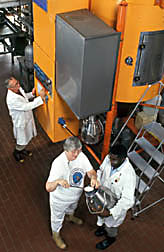Dairy Science to the Defense
Now military personnel and others can enjoy a low-lactose powdered milk.
The U.S. Army asked the Agricultural Research Service for help. And chemist Virginia H. Holsinger gave them what they asked for: pleasant-tasting, reconstituted powdered milk with reduced lactose.
Members of the military who are lactose intolerant tend to avoid milk products. Like millions of others, they lack the lactase enzyme in their intestines that breaks down lactose, the major type of sugar in milk.
If these people drink a glass of regular milk, they develop unpleasant symptoms, such as bloating, cramps, diarrhea, gas, and nausea.
As a health-conscious nation, we know that lack of milk in the diet can lead to calcium deficiency, which in turn can cause other problems.
Scientists at the U.S. Army's Natick Laboratories approached Holsinger to discuss the possibility of developing a low-lactose powdered milk. She leads the Dairy Products Research Unit at the ARS Eastern Regional Research Center (ERRC) in Philadelphia, Pennsylvania.
In earlier work, Holsinger and colleagues showed that lactase, the enzyme that breaks down lactose, could be used to convert lactose in liquid milk into glucose and galactose, simple sugars that are easier to digest. This research is the basis for all the Lactaid products, which include an assortment of lactose-modified dairy foods and lactase in liquid and tablet form for home use.
"The Department of Defense wanted this powdered milk product for their field rations," says Holsinger. So she and colleagues in the ERRC dairy unit set to work.
"First, field rations are noted for their less-than-ideal taste. And the taste of reconstituted nonfat dry milk has not been appealing to our troops. This means," Holsinger says, "that it's not just the lactose-intolerant ones who pass on the powdered milk now being offered, but also those who just don't like the taste.'"
She explains, "We knew that breaking down lactose to glucose and galactose before drying fluid milk causes browning and burning by the dryer's hot surfaces.
"We thought another approach might be to add enzymes to the dry, fat-containing powder to break down the lactose later, when the powder was reconstituted and consumed. But we didn't know the stability of the enzymes in dry form under highly variable storage conditions."
Requiring no refrigeration, the spray-dried, free-flowing dehydrated butter powder provides a new outlet for surplus butter.
The researchers knew that Lactaid, Inc., of Pleasantville, New Jersey, had developed tablets containing lactase from the fungus Aspergillus oryzae. Taken with a meal, two of these tablets will handle the lactose in a glass of milk.
Says Holsinger, "Medical research sponsored by Lactaid, Inc., had shown that lactase enzyme from the fungal source would break down milk lactose under acid conditions in the stomach."
So, using A. oryzae lactase, Holsinger dry-blended the enzyme into a nonfat milk powder made with vegetable oil to yield 2-percent-fat milk when mixed with water.
To check storability, she sealed containers of the powder at room temperature for 6 months.
The enzyme in the dry milk mixture lost none of its activity. And when stored at temperatures typical of a hot climate, the enzyme still retained 90 percent of its activity.
"We had just what the Army ordered," says Holsinger, "a milk-based beverage powder that, when reconstituted and consumed, provides the nutritional advantages of skim milk and unsaturated vegetable fat."
This new product is only one of several that have come from Hollinger’s dairy research.
She and ERRC colleagues recently released a spray-dried, free-flowing dehydrated butter powder that can replace conventional shortening.
"We made it from butter oil, nonfat dry milk, and other food ingredients," says Holsinger. "It gives a delectable butter flavor to cakes, pie crusts, and other baked goods when used in dry bakery mixes." The mixture is simply milk fat and other dairy ingredients encapsulated in all-purpose flour.
Requiring no refrigeration, the butter powder provides a new outlet for surplus butter.
Holsinger used the spray-dry technique to develop a whey/soy drink mix that was used as a dietary supplement for preschool children in developing countries.
"We showed that mixtures of cheese whey and soy flour could be spray-dried and reconstituted without changing the rehydration properties," she explains.
Holsinger's work with surplus commodities prompted requests from AID and USDA's Foreign Agricultural Service for special assignments in India and Mexico to advise on ways to use surplus stocks of nonfat dry milk sold or donated to those countries. — By Doris Stanley, ARS.
USDA-ARS Dairy Processing and Products Research Unit, Eastern Regional Research Center, 600 East Mermaid Lane, Wyndmoor, PA 19038: phone (215) 233-6703.
"Dairy Science to the Defense" was published in the October 1995 issue of Agricultural Research magazine.







